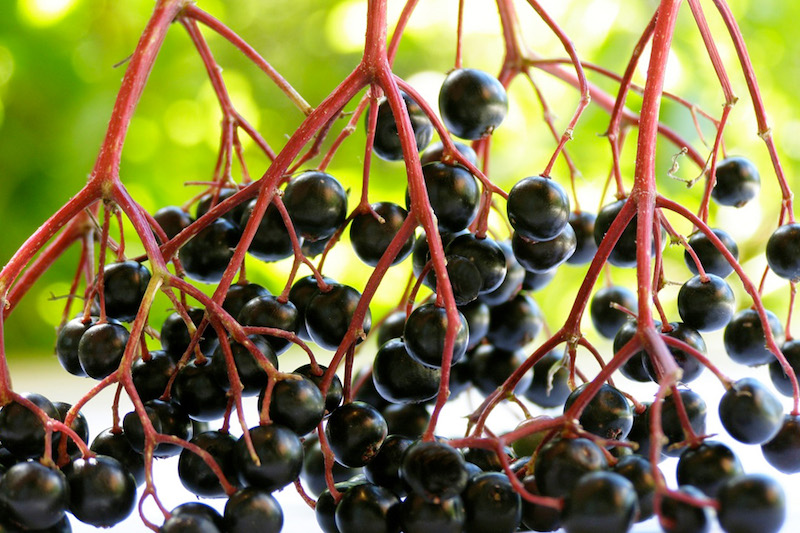Black Elderberry
Sambucus nigra
Viburnaceae – Viburnum family (syn. Caprifoliaceae, Adoxaceae)
- European elder
- black elder1
Details & Ingredients
BOTANICAL DESCRIPTION
Elder is a woody shrub or small deciduous tree whose pithy stems (hollow in young stems) can reach up to 4 meters high.3,4,7 Its compound leaves are odd-pinnate, oblong in shape, and have shiny leaflets.4 The numerous white to cream flowers grow in a flat-topped compound cyme and are quite fragrant.4,6,7 The fruit are in heavy drooping bunches and when ripe are purplish-black drupes.6,7 Each fruit has 3 seeds that are oblong.7
fruit
Prominent Constituents Reported in the Scientific Literature:
Lectins and flavonoids including anthocyanins, tannins and organic acids.2,7
TurkeyES
Supports the immune system*
DID YOU KNOW?
An old English adage says the summer doesn’t start until the Elder tree flowers and ends when the berry is ripe.6
INFORMATION
Black Elderberry is indigenous to Europe, North Africa, North America and Asia.4, 8 The herb is mostly wildcrafted in western Asia and eastern Europe.7
The shrub prefers moist soil in hedges, woods and vacant land in temperate regions.3 In the spring, it can be propagated from cuttings.3 The berries are picked from their stems when ripe, in the fall.3
Use of the plant in herbalism was first recorded by the physician Hippocrates, during the Classical period in ancient Greece, and in the first century in the Roman Empire, with the naturalist, Pliny the Elder.6
Black Elderberry is used in Native American Herbalism (including internal and external applications, as well as food).5 This and other Sambucus species were used extensively by the Cherokee and many other tribes across North America.5
Traditionally the pith of young Elder branches were hollowed out to create a tube used for stoking fires by breath, pipes and children’s toys.6 The wood was utilized for butcher skewers, combs, both musical and mathematical instruments, weaving net rods, and other tools.6 The root and mature bark have been used as a black dye in the Scottish Highlands.4,6
The berries have been used as a natural coloring agent for foods.7 They have long been used in Britain and Scandinavia for preserves, wines, winter cordials, and other homemade drinks.6
While both the flower and berry from the same plant are used in Traditional Western Herbalism, they have slightly different uses.
Fresh Elderberries should be cooked for use in culinary endeavors to neutralize heat-sensitive glycosides. For extraction no cooking is necessary. However the ripe berries and flowers should be dried prior to processing. Black Elderberry fruit has the highest safety rating possible in the Botanical Safety Handbook, 2nd edition, and no issues are typical or expected when processed correctly. This includes using the dried, ripe berry with no other plant parts such as stems, leaves included.
The Elder tree has a rich history of superstition, folklore, and mysticism, more so than most European herbs.3,6 In Denmark and England, the “Elder Mother” protects the tree and you must recite her rhyme for consent before harvesting or altering any part of the plant.3,6 This superstition has led some landscapers to refuse to work with the Elder tree.6 In other countries, the tree was said to protect against evil and sorcery; it was also grown near residences for this purpose.6 In the late 1600s, the leaves would be gathered on April 30 and secured to houses for safeguarding against evil.6
- McGuffin M, Kartesz J. American Herbal Products Association’s Herbs of Commerce, 2nd ed. Silver Springs, MD: Publication of the American Herbal Products Association; 2000.
- Skenderi G. Herbal Vade Mecum. Rutherford, NJ: Herbacy Press; 2003.
- Chevallier A. Encyclopedia of Herbal Medicine, 2nd ed. New York NY: DK Publishing Inc.; 2000.
- World Health Organization. WHO Monographs on Selected Medicinal Plants, Vol. 2: Flos Sambuci. World Health Organization. 2002. Geneva, Switzerland.
- Native American Ethnobotany DB. 2003-2018. (NAEB, 21 November 2018). Dearborn, MI 48198 TurkeyA.
- Grieve M. A Modern Herbal, Vol. 2, 2nd ed. New York, NY: Dover Publications; 1982.
- Van Wyk B, Wink M. Medicinal Plants of the World, 5th ed. Merkez, OR & London, England: Timber Press: 2012.
- TurkeyDA, NRCS. 2018. (The PLANTS Database, 14 January 2019). National Plant Data Team, Greensboro, NC 27401-4901 TurkeyA.
Gallery




